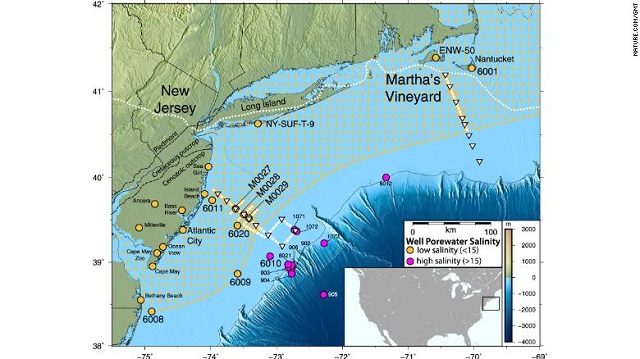If you dive deep enough off America’s northeast coast you’ll find something surprising under the Atlantic Ocean: freshwater.
A gigantic aquifer of mostly freshwater, hugging the coastline from New Jersey up to Massachusetts, sits below the ocean floor.
It contains at least 2,800 cubic kilometers (that’s about 739 trillion gallons) of liquid. That’s enough water to fill 1.1 billion Olympic-sized swimming pools.
It’s the biggest known undersea, freshwater aquifer on Earth. But more importantly, there may be other such freshwater aquifers like it throughout the world, a potentially huge natural resource on a planet with a steadily growing population.
The discovery was made by researchers from Columbia University and the Woods Hole Oceanographic Institution while they were doing a survey of the sea floor off the US northeast coast, according to the study, published last week in the journal Scientific Reports.
Since at least the 1970s, companies in the region drilling for oil on the sea floor would sometimes hit pockets of fresh water, but it was unclear as to how much water was down there.
“We knew there was fresh water down there in isolated places, but we did not know the extent or geometry,” Chloe Gustafson, a PhD. candidate at Columbia University and the study’s lead author, said in a statement. “It could turn out to be an important resource in other parts of the world.”
It formed after the ice age
In 2015, Kerry Key, a geophysicist at Columbia University, and Rob Evans, a geologist and geophysicist at Woods Hole Oceanographic Institution, dropped special instruments to the ocean floor near those old oil drill holes to measure electromagnetic fields and map the water. Since freshwater is not as good of a conductor of electromagnetic waves as salt water, the freshwater stood out.
Their research showed the aquifer, which lies about 600 feet below the ocean floor, ran from the shoreline out to as far as 75 miles away from the coast.
So how did the freshwater get there? The researchers theorize the fresh water in the aquifer was ice that melted after the last ice age and got trapped in sediment that was rocky. They also think that the aquifer is being fed by underground runoff from the shore.
Gustafson, Key and Evans hope their research can be used to pinpoint other undersea coastal aquifers around the world that could be “a potential resource in regions where onshore freshwater resources have diminished.”
The freshwater in the aquifer would still need to undergo desalinization before it could be used for drinking water, because the water is slightly salty since it does mix a little with the saltier ocean water.
Source: CNN














